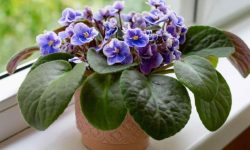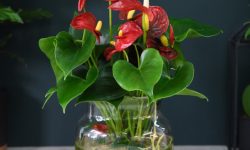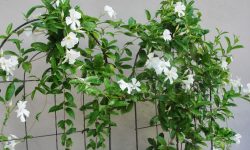Indoor gardens are enhanced by air plant flowers. These unusual blooms add to the allure of air plants because they come in a variety of colors and shapes.
You can select from 30 various types of air plant flowers to get the perfect one for your interior space by reading the article below.
Different Types of Air Plant Flowers
Brachycaulos
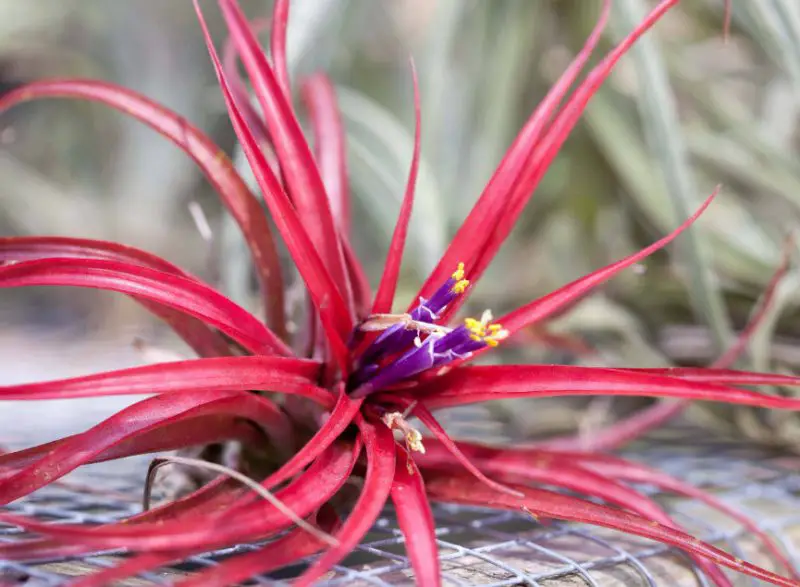
The Brachycaulos air plant, or Tillandsia brachycaulos, is native to Mexico, Central America, and Venezuela. It grows to a height of 2 to 8 inches in USDA zones 9 through 11. Its leaves radiate outward from a central point, soaking up intense, indirect light. As it gets ready to blossom, the plant turns crimson. Certain varieties could have red-dyed leaves that resemble blossoming. It is usually a little plant that reaches a height of about 3 inches and a spread of 4 inches, though certain cultivars may grow taller. The brachycaulos x concolor hybrid was created with the express purpose of preserving its vivid green hue.
Bulbous Air Plant
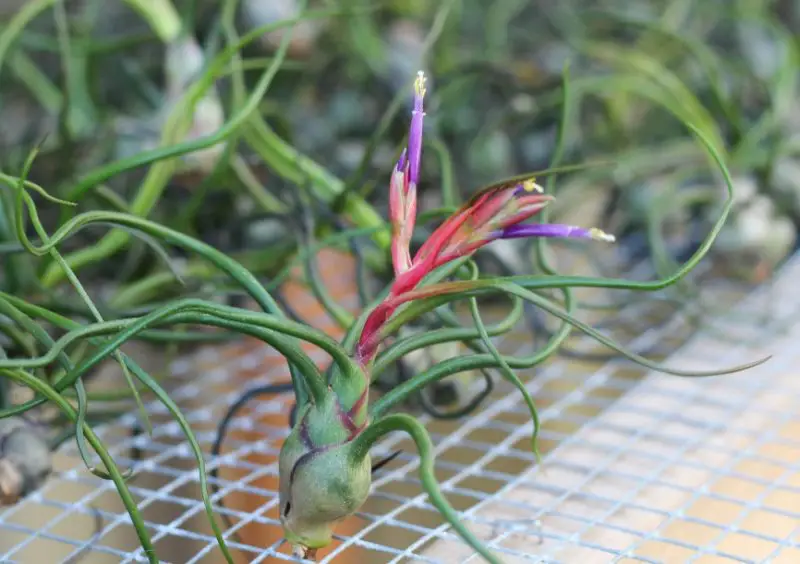
The Bulbous Air Plant, scientifically known as Tillandsia bulbosa, originates from Southern Mexico, Central America, and South America, thriving in USDA zones 9-11 and standing 4-7 inches tall. Flourishing in bright, indirect light or partial shade, its distinctive bulbous roots inspire its common name. The contorted, narrow leaves resemble tentacles, changing to purple or red just before blooming. Outdoors, Tillandsia bulbosa engages in a symbiotic relationship with ants, as their homes inside the somewhat hollow bulbs provide nutrients from their waste for the plant’s nourishment.
Cacticola
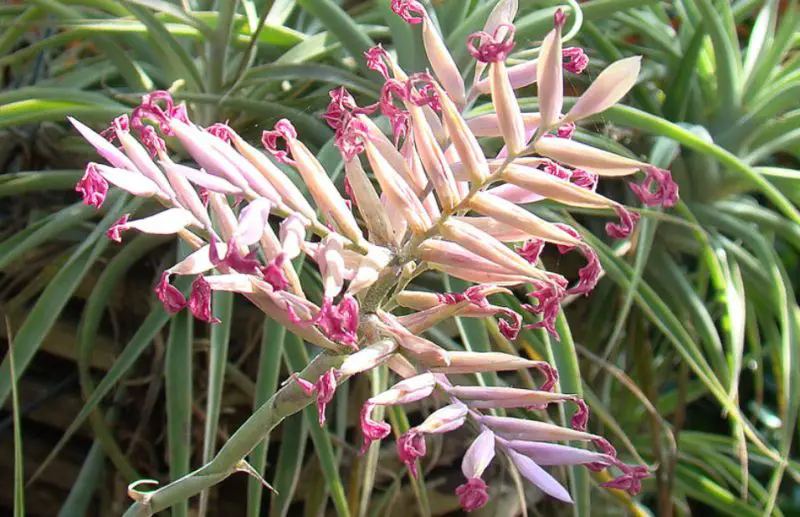
Originating in Peru, the Cacticola (Tillandsia cacticola) grows well in USDA zones 9–11. Because of its low offset output, it is a rare cultivar. But what really draws people in are the gorgeous lavender blooms. A long stalk bearing a silvery-green rosette appears, carrying the bloom 8–9 inches above the plant. Grows on cacti, hence its apt name.
‘Peach’ Air Plant
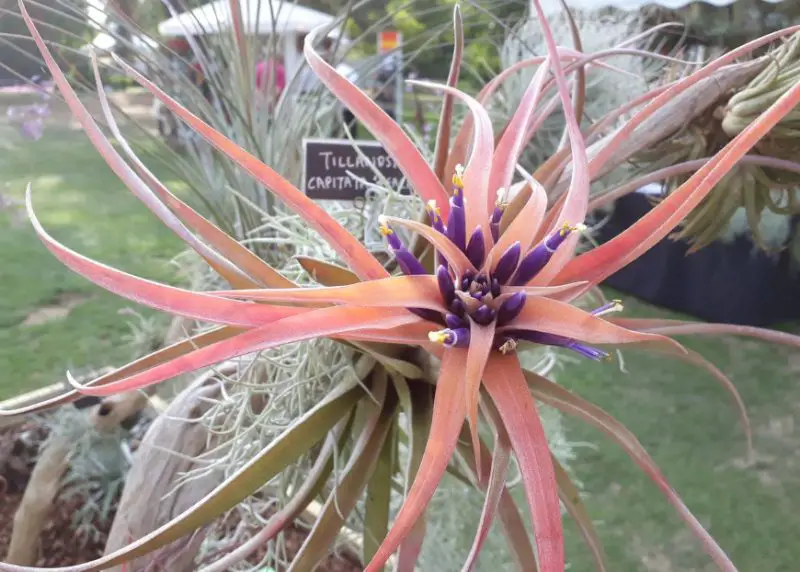
Scientifically known as Tillandsia capitata ‘Peach,’ the ‘Peach’ Air Plant is native to Mexico, Honduras, Cuba, and the Dominican Republic. It grows to a height of 2-8 inches and thrives in USDA zones 9-11. Its thick, surprisingly delicate leaves form a silver-green rosette that changes to a peachy-pink hue before blooming. It thrives in bright, indirect light and can withstand full sun. Its purple blossoms make a dramatic contrast to the vibrant peach coloration.
Circinata
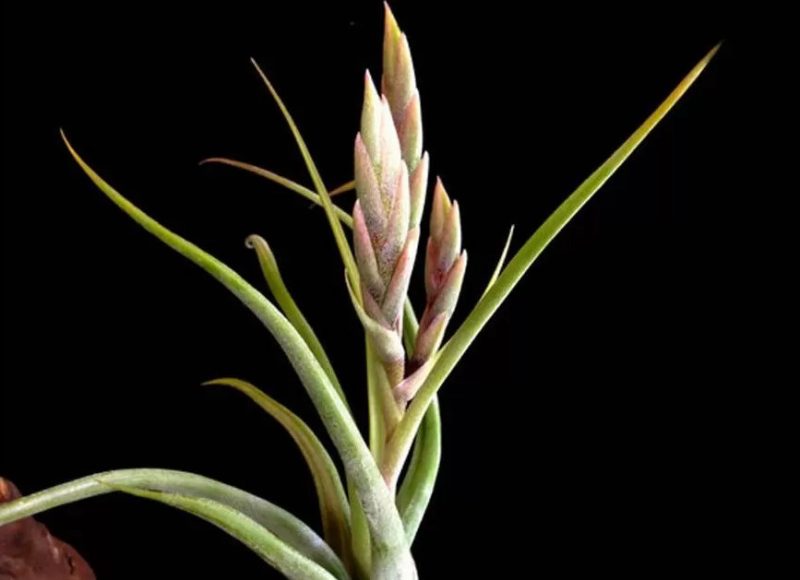
Tillandsia circinata, which is native to Mexico, Costa Rica, and the Bahamas, grows well in USDA zones 10–11 and is 6–8 inches tall. Growing in bright indirect light or light shade, it has a robust look with thick silvery-green leaves that resemble a fennel bulb. Circinata plants grow to a height of 6 to 8 inches with a base diameter of about 1 inch. They bloom in either yellow or purple.
‘Cotton Candy’
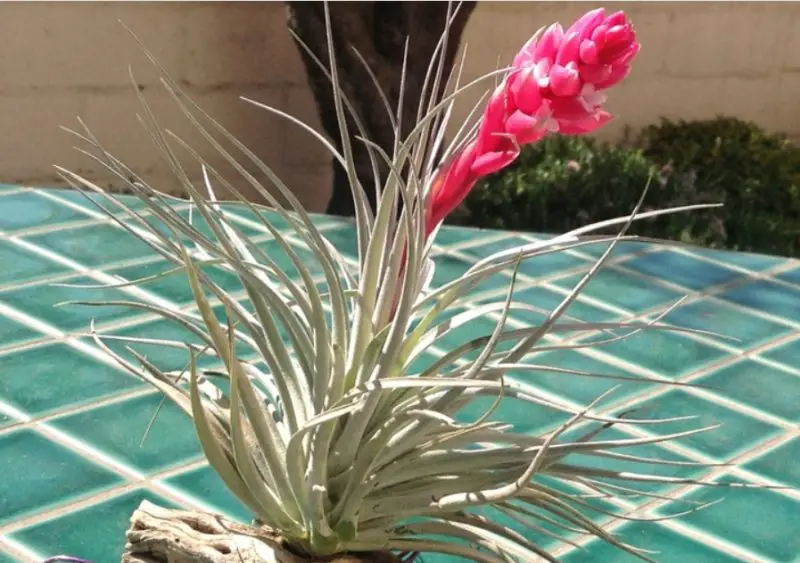
Native to South America, ‘Cotton Candy’ (Tillandsia stricta x T. recurvifolia) is a hybrid. Growing to a height of 5 to 6 inches (up to 12 inches), it thrives in USDA zones 9 through 11. It needs bright, indirect light. The long, thin, silvery leaves of this hybrid resemble loose spider dahlias. The inflated appearance of the bracts adds to the attraction of this flower spike, which is bred for a bright pink color. Excellent blossoming necessitates extremely intense light.
Loliacea
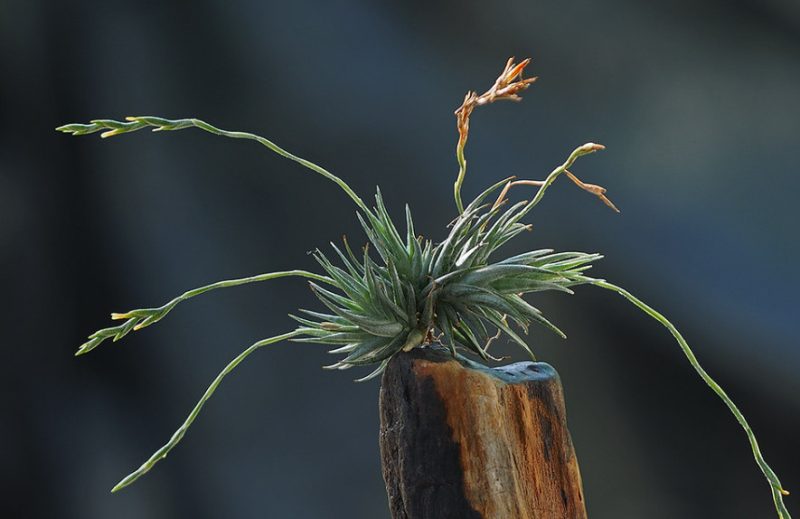
The Loliacea (Tillandsia loliacea) is a lovely charmer for fans of small air plants. It grows well in USDA zones 9–11 and is native to Bolivia, Brazil, and Argentina. It is 1-3 inches tall. This small plant, which never grows much larger than 1 1/2 inches, is bathed in bright, indirect light. Its blossom stalk reaches up to 2-3 inches, presenting similarly tiny yellow flowers. These little air plants are attractive whether they are grouped in terrariums or resting on wood, and they absorb excess moisture.
Didsticha
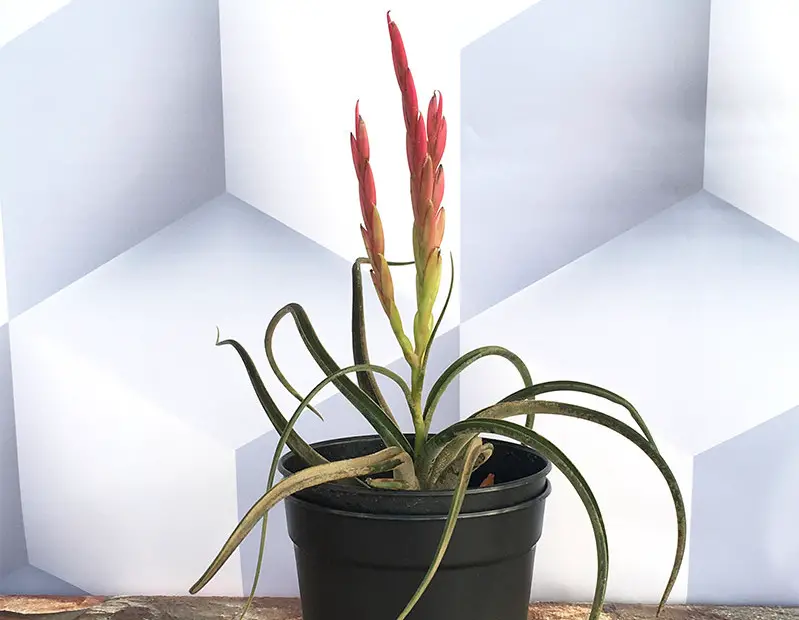
Native to Bolivia and Brazil, the Didsticha (Tillandsia didsticha) grows to an amazing height of 6 to 12 inches and thrives in USDA zones 9 through 11. Its base generates an airy spray of slender, pointed, gray-green leaves, bathed in bright, indirect light. From its base rises the flower stalk, embellished with tiny white flowers and pinkish bracts.
Dyeriana
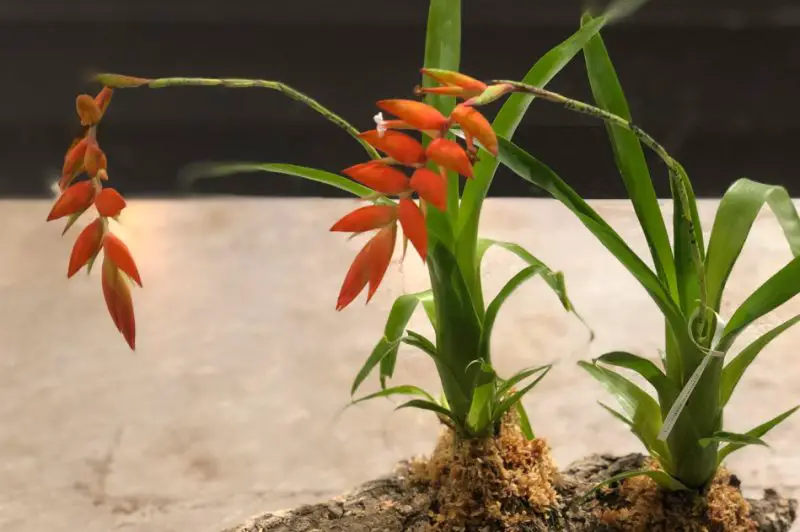
The Dyeriana, or Tillandsia dyeriana, is native to Mexico, Central America, and Ecuador. It grows to a height of 3 to 12 inches and does well in USDA zones 10 through 11. With its vivid orange inflorescence, it exudes a tropical flair and is bathed in strong, indirect light. The bracts’ flamboyance steals the spotlight, even if the primary flowers are white. Notably, Dyeriana is one of the few varieties of air plants that can grow to a significant height of 12 to 18 inches in pots. Enough humidity must be provided for it to be healthy.
Giant Air Plant

Known by its scientific name Tillandsia fasciculata, the giant air plant is indigenous to northern South America, the West Indies, Mexico, and Central America. It thrives in USDA zones 9 through 11 and can grow as tall as three feet. This species, which thrives in bright, indirect light, goes by several common names, such as enormous air plant, quill-leaf air plant, cardinal air plant, and wild pineapple. It is widely grown and has several hybrids and variants. It stands out from other air plants with its stunning red and green inflorescence that lasts for weeks.
Flabellata
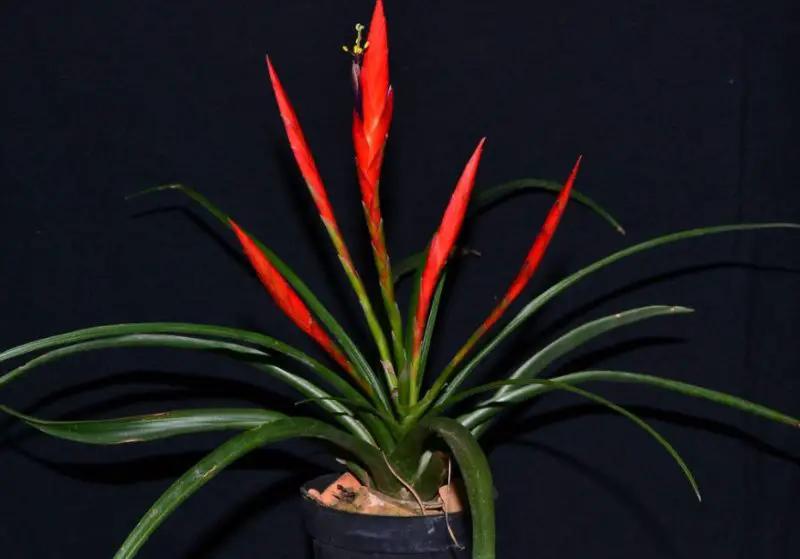
Native to Mexico and Central America, Tillandsia flabellata grows to a remarkable height of vase shape and a cascade of red flower spikes that is frequently compared to a candelabra. It thrives in USDA zones 9–11. Flabellata is a notable air plant that may grow up to 12 inches tall, making it comparatively larger than other species. Within the realm of air plants, it has a unique morphology, flourishing in bright, indirect light.
Argentea
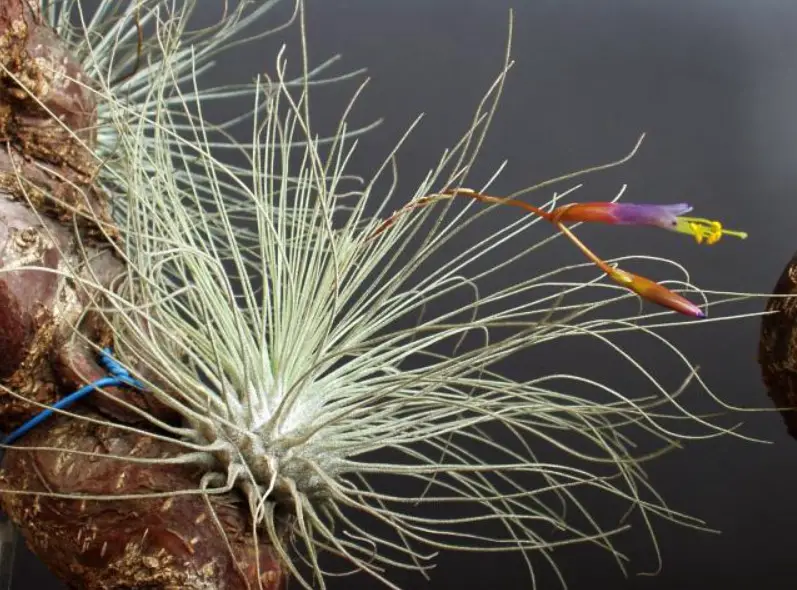
The Argentea air plant, which grows best in USDA zones 9–11, is native to Mexico, Guatemala, Cuba, and Jamaica. It was formerly known as Tillandsia argentea or Tillandsia fuchsii var. garcilis. This small plant has a bulbous base that resembles a pincushion and long, very thin gray-green leaves that are 1-2 inches broad and 5-6 inches high. This unusual air plant is made more alluring by the tiny appeal that even its dramatic orange-red flowering preserves. A striking addition to any collection, it thrives in bright, indirect light.
Funkiana
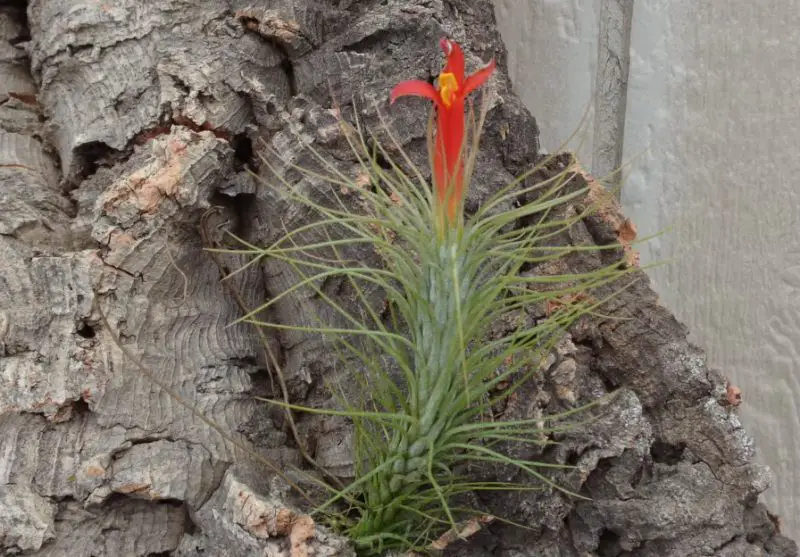
Known by its scientific name, Tillandsia funkiana, the Funkiana air plant is native to Venezuela and grows best in USDA zones 9 through 11. These air plants’ extended forms allow them to bend and twist gracefully into odd shapes—sometimes even swirling around themselves. The Funkiana plant is a great option for terrariums or desktop plants, even though it is only 2 inches tall. Like many other varieties of air plants, its leaves change, becoming red in anticipation of blossoming. Following suit, the inflorescence is charmingly ornamented with yellow flowers and scarlet bracts.
Gardneri
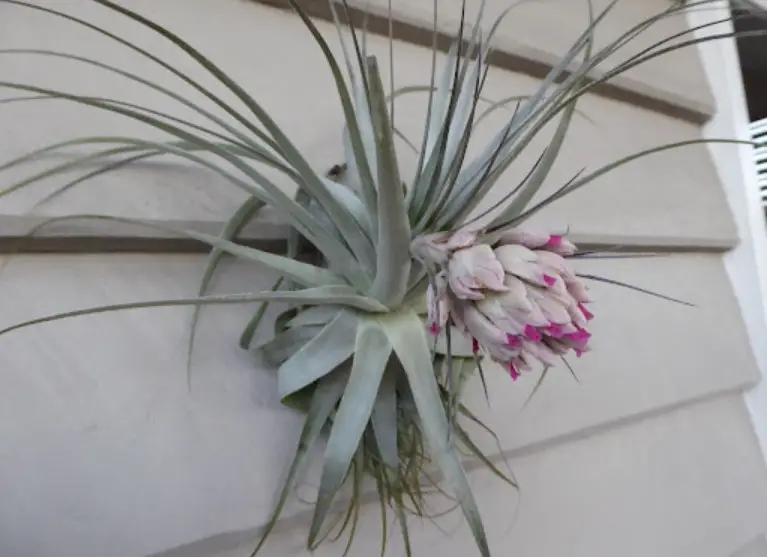
USDA zones 9–11 are ideal for the Gardneri air plant, also known as Tillandsia gardneri, which is native to Trinidad and Tobago, Colombia, eastern Brazil, and Venezuela. Its pale grayish leaves taper to a point, giving it a yucca-like appearance. This larger air plant reaches a height of 12 inches. For people who might find it difficult to provide their air plants the bright light and warm temperatures that most of them require, Gardneri is a good option. Even though it’s forgiving, it still needs a lot of moisture to develop well.
Ball Moss
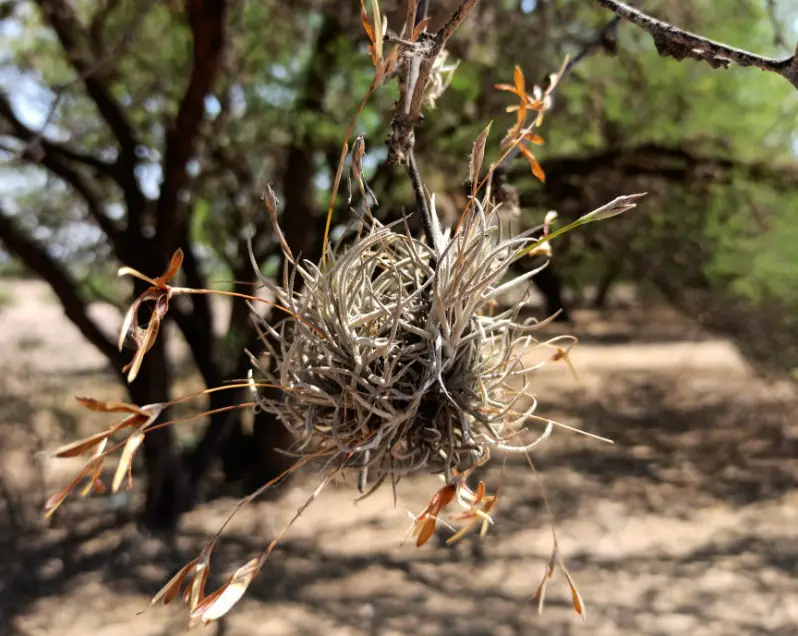
The Ball Moss, or Tillandsia recurvata, is native to the Southeastern U.S., Central America, and Chile to northern Argentina, thriving in USDA zones 9-11. Commonly known as small ball moss, it features a nest-like shape with a mass of slender, arching gray-green leaves and a tall lavender flower spike. This air plant often naturalizes in the Southeastern United States and has the peculiar habit of allowing its seeds to germinate while still in the seed pod, making it exceptionally easy to propagate. Flourishing in bright, indirect light, it adds a unique touch to any collection.
‘Pink Bronze’
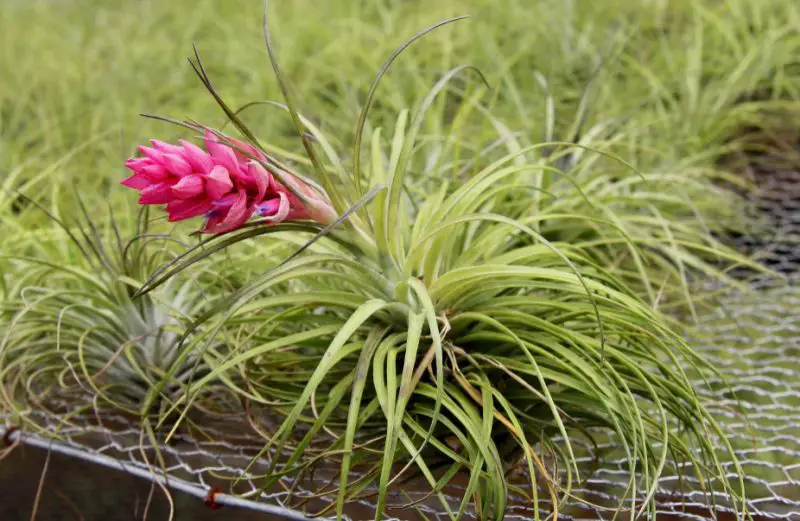
Tillandsia stricta ‘Pink Bronze,’ often known as the ‘Pink Bronze’ air plant, is indigenous to South America and Trinidad & Tobago. It grows best in USDA zones 9–11 and reaches a height of 6–12 inches. This variety thrives in bright, indirect light and, in strong, brilliant light, forms a pineapple-like rosette of leaves with a tinge of pinky-bronze coloration. But the big purple and pink blossoms are the ones that really steal the scene. It’s a popular single specimen that gives little teardrop terrariums an enthralling touch.
‘Whitestar’
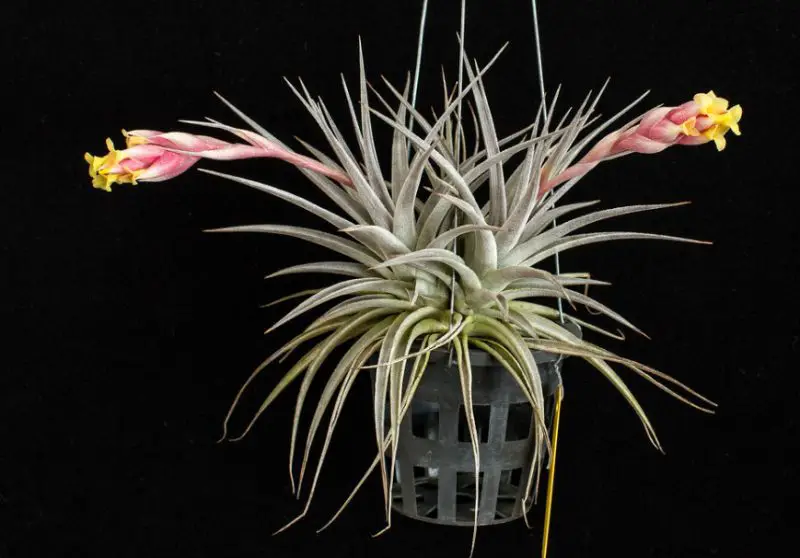
‘Whitestar’ is a nursery hybrid, resulting from the genetic cross between Tillandsia ixioides and T. recurvifolia, both native to South America. Thriving in USDA zones 9-11, this hybrid grows significantly larger, reaching a height of 6-12 inches. Displaying rosy pink bracts and cream to yellow flowers, ‘Whitestar’ stands out with silver-gray leaves that gracefully curl, creating a sense of movement and adding to its unique charm. Flourishing in bright, indirect light, it’s a distinctive addition to any air plant collection.
Xerographica
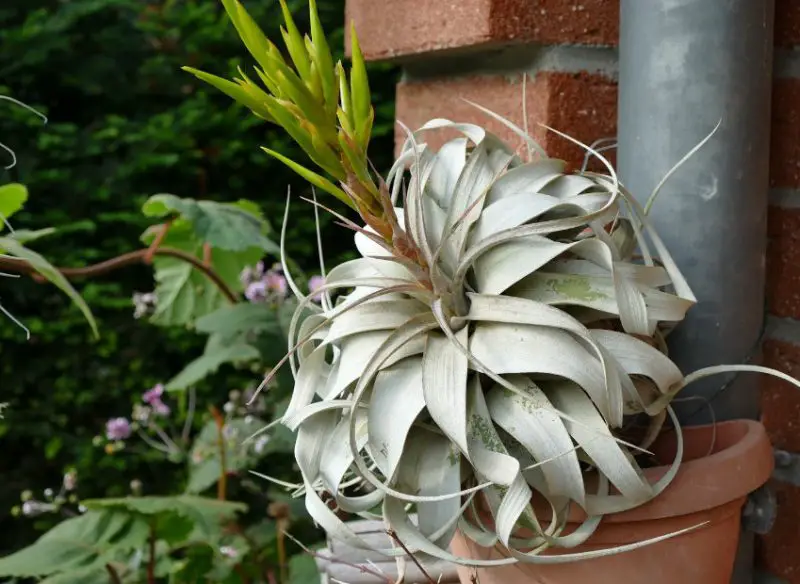
Known by its scientific name, Tillandsia xerographica, the xerographica air plant is native to Mexico and Central America. It grows best in USDA zones 9 through 11. It grows best in bright, indirect light and can withstand brief exposure to direct sunlight. It is 6 to 15 inches tall. Distinguished by its atypically broad, level, gray-green foliage that undulates akin to ribbons, this air plant creates a remarkable impression when arranged with more diminutive air plants.
Sky Plant
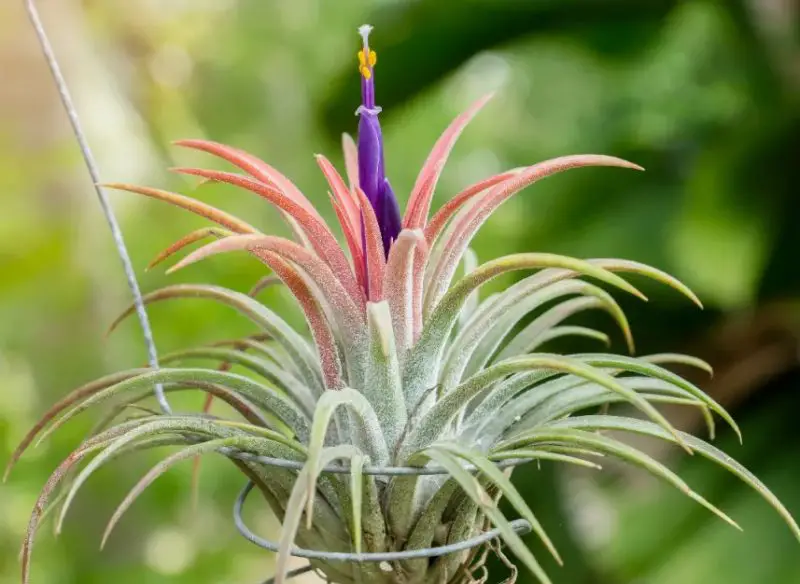
Originating in Mexico, Central America, and South America, the sky plant is known as Tillandsia ionantha. It grows to be 6–12 inches tall and thrives in USDA zones 9–11. This air plant, known for its durability and attractiveness, prefers bright, indirect light. Its violet-colored blooms and silvery-green foliage that change to scarlet and pink make it a beloved option for fans of air plants.
‘Druid’ Sky Plant
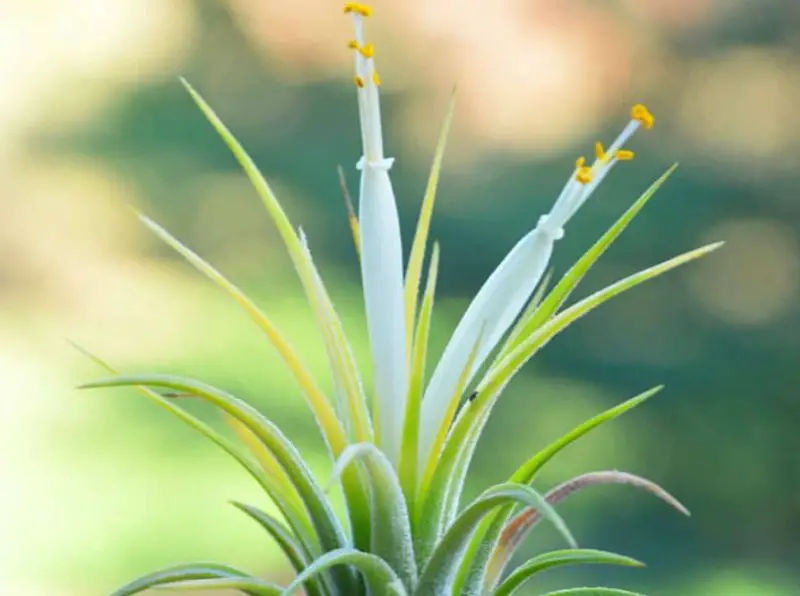
A variation of Tillandsia ionantha, the ‘Druid’ Sky Plant is native to Central and South America. Standing 2-4 inches tall, it thrives in USDA zones 9–11 and is drawn to bright, indirect light. Stepping away from the traditional red color, the ‘Druid’ has peachy-pink leaves and white flowers, which add a distinctive touch to the colorful world of air plants. Its allure enchants admirers despite its little stature.
‘Maxima’ Sky Plant
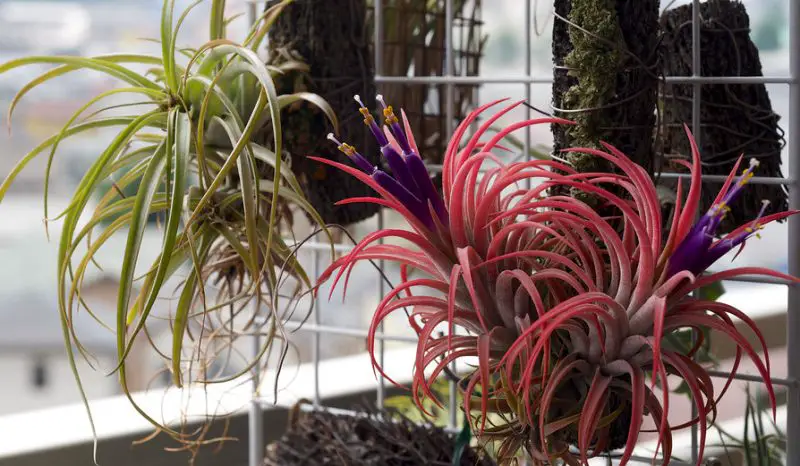
The ‘Maxima’ Sky Plant, also known as Tillandsia ionantha ‘Maxima’ or ‘Huamelula,’ is native to Mexico, Central America, and South America. It grows to a height of 5 to 6 inches and thrives in USDA zones 9 through 11. It does well in fluorescent light and can withstand intense sunlight or some shade. With its vibrant coral-red foliage and eye-catching purple blossoms, this sturdy air plant shines out. Considering that it is huge for its species, measuring 5–6 inches high and 3–4 inches broad, it is a notable option for fans of air plants looking to add striking floral accents.
‘Fuego’ Sky Plant
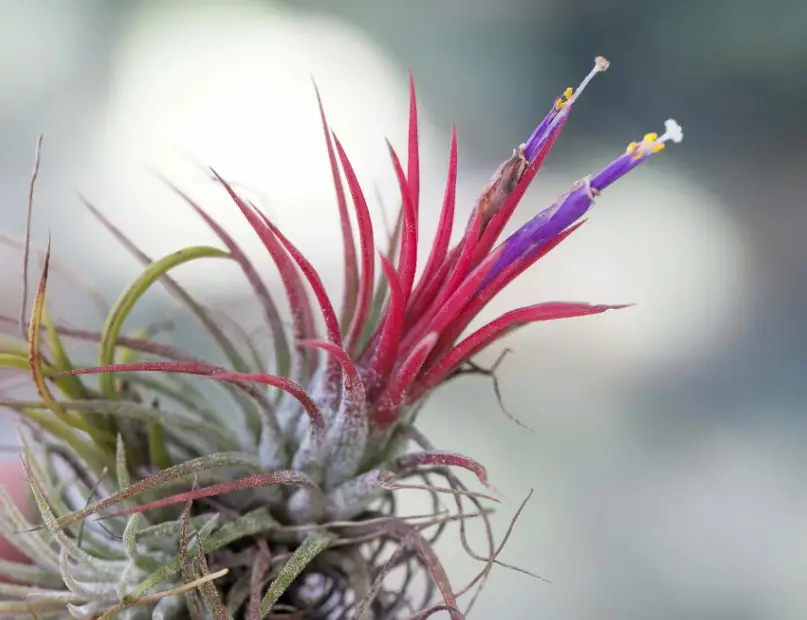
The ‘Fuego’ Sky Plant is a variation of Tillandsia ionantha that grows 1/2 to 3 inches tall and is native to Mexico, Central America, and South America. It thrives in USDA zones 9-11. Situated in bright, indirect light, ‘Fuego’s’ long blushing leaves steal the show, keeping their vivid color for months. Even though they are only a little over an inch tall, these plants quickly fill out to become a compelling focal point in any arrangement or a delightful conversation starter on tabletops.
Pink Quill Plant
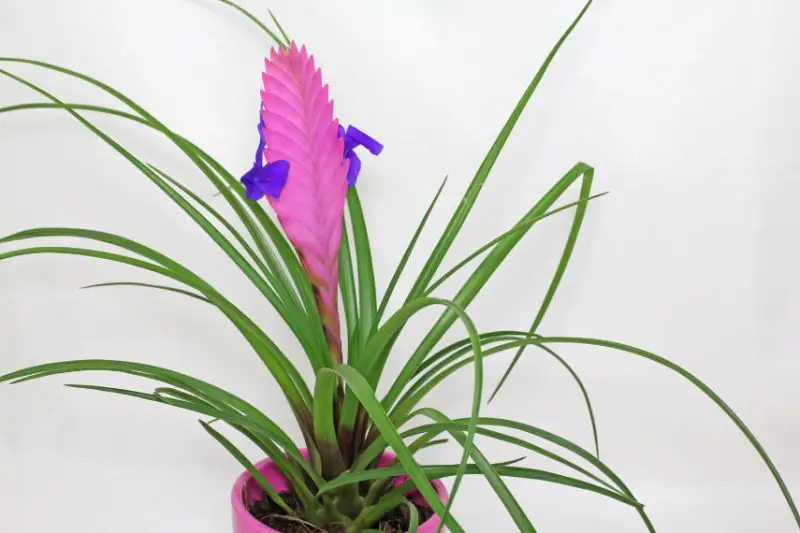
Tillandsia cyanea, the scientific name for the pink quill plant, is native to Ecuador. It grows best in USDA zones 9 through 11, with a maximum height of 8 to 12 inches. Growing best in bright, indirect light, this species gets its name from feather-like pink bracts that are emphasized by purple flowers. Tillandsia cyanea is not like other common air plants in that it can be grown in soil, but it can also be grown without it as long as it gets enough moisture.
Mad Pupper
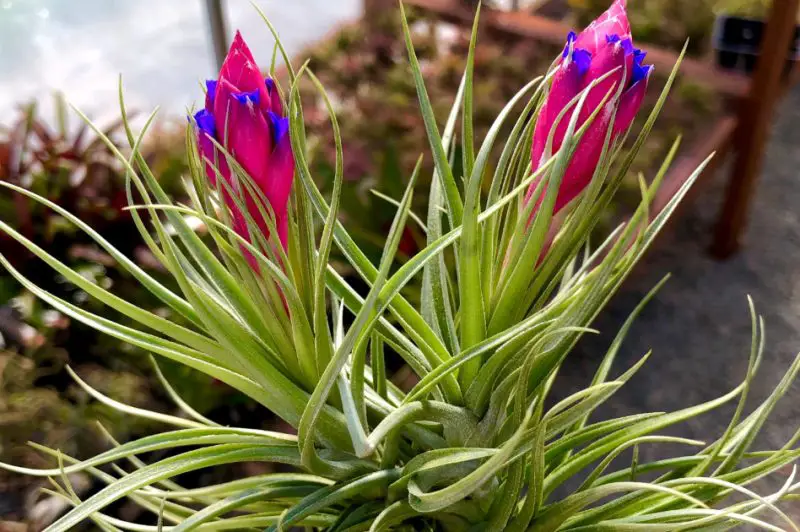
Standing 6–10 inches tall, the Mad Pupper (Tillandsia aeranthos bergeri) is a native of South America that thrives in USDA zones 9–11. Known alternatively as Tillandsia aeranthos bergeri, this colorful air plant consistently blooms in the spring with vivid, spiky pink and blue blossoms. Thanks to its humorous common name, Mad Pupper, it has grown to be a favorite among fans of air plants. It is well-known for being low-maintenance and thrives in fluorescent or strong indirect light, making it a simple and enjoyable addition to any collection.
‘Kolbii’
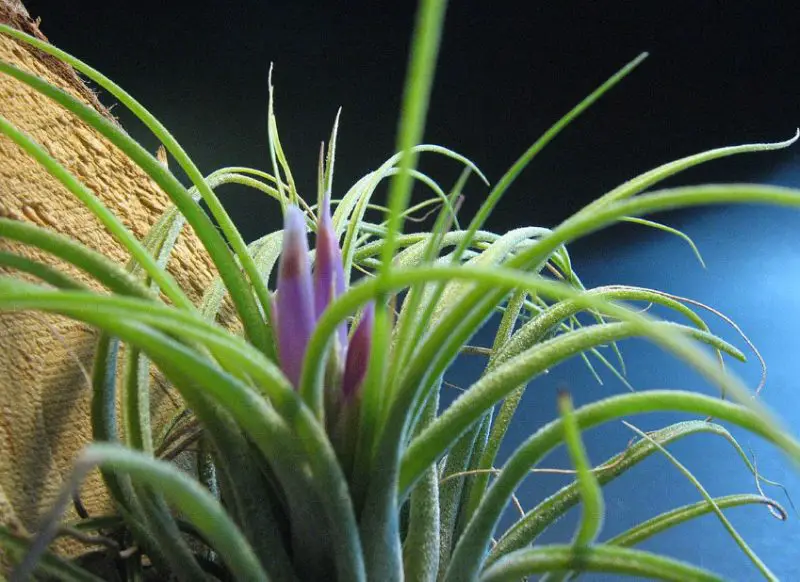
Officially named Tillandsia scaposa ‘Kolbii,’ this air plant is native to Guatemala and grows 2–5 inches tall in USDA zones 9–11. In contrast to some unusually growing air plants, ‘Kolbii’ grows tall and straight in a close cluster that resembles a bunch of celery. Its delicate gray fuzz on the leaves, especially when they blush pink before blooming, makes it stand out despite its diminutive stature. Several names for this variety exist, including T. scaposa ‘Kolbii,’ T. kolbii, and T. ionantha var. scaposa.



